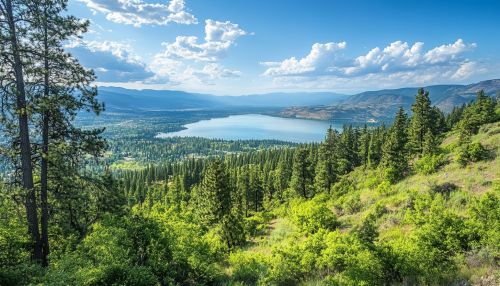Syilx
Introduction
The Syilx people, also known as the Okanagan Nation, are an Indigenous people whose traditional territory spans the southern interior of British Columbia, Canada, and extends into northern Washington State, USA. The Syilx are part of the Interior Salish linguistic group and have a rich cultural heritage deeply connected to the land, water, and natural resources of their region. This article delves into the history, culture, language, and contemporary issues facing the Syilx people.
History
Pre-Contact Era
The Syilx people have inhabited their traditional territory for thousands of years. Archaeological evidence suggests that their ancestors lived in the region as far back as 10,000 years ago. The Syilx developed a complex society with a deep understanding of the local ecology, which allowed them to thrive in a diverse landscape that includes mountains, valleys, rivers, and lakes.
The Syilx were semi-nomadic, moving seasonally to take advantage of different resources. They practiced a subsistence lifestyle, relying on hunting, fishing, and gathering. Salmon was a staple in their diet, and they utilized sophisticated fishing techniques to harvest this vital resource. The Syilx also gathered a variety of plants, berries, and roots, which were essential for their nutrition and medicinal purposes.
Contact and Colonization
The arrival of European explorers and fur traders in the late 18th and early 19th centuries marked the beginning of significant changes for the Syilx people. The fur trade introduced new goods and technologies but also brought diseases that had devastating effects on Indigenous populations. The establishment of trading posts and settlements led to increased pressure on Syilx lands and resources.
In the mid-19th century, the Fraser River Gold Rush and subsequent settlement by European colonizers further encroached on Syilx territory. The imposition of colonial laws and policies, such as the Indian Act in Canada, disrupted traditional governance structures and led to the displacement of many Syilx communities.
Resistance and Resilience
Despite the challenges posed by colonization, the Syilx people have demonstrated remarkable resilience. They have actively resisted efforts to assimilate them into the dominant culture and have worked to preserve their language, traditions, and way of life. The Syilx have engaged in legal and political battles to assert their rights and protect their land and resources.
One notable example of Syilx resistance is the Okanagan Trail of Tears, a protest in the early 20th century against the Canadian government's policies of land dispossession and cultural assimilation. This protest highlighted the ongoing struggle for recognition and justice faced by the Syilx people.
Culture
Language
The Syilx language, known as Nsyilxcən, is a member of the Interior Salish language family. It is an integral part of Syilx identity and cultural heritage. Efforts to revitalize and preserve the language are ongoing, with language programs and initiatives aimed at teaching Nsyilxcən to younger generations.
Nsyilxcən is a polysynthetic language, characterized by complex word structures and a rich system of verb conjugation. The language reflects the Syilx worldview, with many words and expressions tied to the land, water, and natural environment.
Social Structure
Traditional Syilx society was organized around extended family groups, or kinship networks, that were central to social and economic life. Leadership was based on consensus and respect for elders, who played a crucial role in decision-making and the transmission of cultural knowledge.
The Syilx people practiced a form of governance that emphasized collective responsibility and stewardship of the land. This approach to leadership and governance continues to influence contemporary Syilx political structures.
Spirituality and Beliefs
Syilx spirituality is deeply connected to the natural world. The Syilx people believe in the interconnectedness of all living beings and the importance of maintaining balance and harmony with the environment. Traditional ceremonies and rituals are an essential part of Syilx spiritual life, serving to strengthen community bonds and reinforce cultural values.
The Syilx have a rich oral tradition, with stories and legends that convey important teachings and historical knowledge. These narratives often feature Coyote, a central figure in Syilx mythology, who embodies both wisdom and trickery.


Contemporary Issues
Land and Resource Rights
The Syilx people continue to advocate for the recognition of their land and resource rights. Legal battles over land claims and resource management have been ongoing, with the Syilx seeking to assert their sovereignty and protect their traditional territories from development and environmental degradation.
The Syilx have been involved in co-management agreements with government agencies to oversee the stewardship of natural resources, such as fisheries and forests. These agreements aim to incorporate traditional ecological knowledge into modern resource management practices.
Cultural Revitalization
Efforts to revitalize Syilx culture and language are a priority for the community. Cultural programs, language classes, and traditional arts and crafts workshops are organized to engage younger generations and ensure the transmission of cultural knowledge.
The Syilx people also celebrate their heritage through annual events and gatherings, such as the Okanagan Nation Salmon Feast, which honors the significance of salmon in Syilx culture and promotes environmental awareness.
Health and Social Issues
Like many Indigenous communities, the Syilx people face challenges related to health and social well-being. Issues such as access to healthcare, education, and employment opportunities are ongoing concerns. The Syilx are actively working to address these challenges through community-driven initiatives and partnerships with government and non-governmental organizations.
Programs focused on mental health, substance abuse prevention, and youth empowerment are key components of the Syilx approach to improving social outcomes and fostering community resilience.
